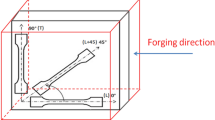Conclusions
Alloy 1163 is superior to alloy D16ch in fracture toughness (10–15%) at the same standard strength level.
Similar content being viewed by others
Literature cited
L. N. Leshchiner and T. P. Fedorenko, “Effect of composition and structure on the properties of aluminum alloy D16”, Metalloved. Term. Obrab. Met., No. 3, 33–37 (1982).
C. Peel, and D. McDardaid, Appl. Improved Aluminum Alloys Steels Aircraft Structures,85, No. 847, 320–326 (1981).
I. N. Fridlyander, L. N. Leshchiner, L. V. Latushkina, and T. P. Fedorenko, “Rules governing changes in the properties with aging of alloy D16”, in: Problems of Metal Science of Nonferrous Alloys [in Russian], Nauka, Moscow (1978), pp. 158–166.
Additional information
Translated from Metallovedenie i Termicheskaya Obrabotka Metallov, No. 8, pp. 43–44, August, 1983, 1983.
Rights and permissions
About this article
Cite this article
Leshchiner, L.N. Wrought aluminum alloy 1163. Met Sci Heat Treat 25, 612–614 (1983). https://doi.org/10.1007/BF00741925
Issue Date:
DOI: https://doi.org/10.1007/BF00741925




